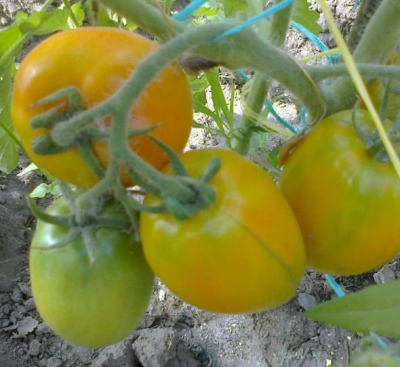
- Authors: Nastenko N.V., Kachainik V.G., Kandoba A.V.
- Year of approval: 2008
- Category: grade
- Growth type: determinant
- Appointment: fresh consumption, for pickling and preserving
- Ripening period: early
- Ripening time, days: 93-95
- Growing conditions: for open ground, for film greenhouses
- Marketability: high
- Bush size: undersized
One of the features of the Fairy Gift variety is the ability to grow tomatoes in different regions of the country, despite the various climatic conditions. This species has gained widespread popularity due to its many positive characteristics. Now it is a favorite variety of many summer residents, including those who grow vegetables for sale.
Breeding history
The authorship of the breeding belongs to N.V. Nastenko, V.G. Kachainik, A.V. Kandoba. They worked and carried out research on crossing in LLC "Agrofirma Aelita". The variety was approved for use in 2008.
Description of the variety
Plant of determinant type. The height of an adult plant is 70-100 centimeters. The leaf blades of the bushes are of medium size, dark green in color. They have a peduncle with an articulation.
It is recommended to form 1-2 stems. The first bud ripens at a height of 7-8 leaves from ground level. The inflorescence is intermediate. Up to 6 brushes are formed on the trunk, from 5 to 8 fruits ripen in them.
Among the advantages are:
taste qualities;
compactness of bushes;
versatility;
unpretentious care;
resistance to adverse weather conditions;
yield;
storage periods;
transportability.
There are few disadvantages, but they are:
pinching;
the need to tie to a support.
The main qualities of the fruit
They have a heart-shaped, slightly ribbed shape. Their color is orange. The skin is smooth. The weight of one vegetable can reach 110-115 g. The pulp is dense. Each tomato has 4 chambers and very few seeds. The tomato is suitable for fresh consumption, making juices, sauces, ketchups and pickling.
Taste characteristics
The Fairy Gift tomato has a sweet taste with a subtle sourness in the aftertaste. The fruits are fleshy, very juicy, with a high content of sugar and dry matter. In addition, ripe fruits are characterized by a high carotene content.
Ripening and fruiting
Vegetable culture belongs to early maturing varieties. Ripening dates are 93-95 days. Under favorable conditions or when grown in a greenhouse, the process of fruiting and ripening is faster. Harvesting begins in July - August.
Yield
High productivity. If you properly care for the culture, from one square. m you can collect 9.3 kg of fruit.
The timing of planting seedlings and planting in the ground
Sowing seeds is carried out 55-60 days before planting in open soil. The seedlings take root quite easily and quickly and are almost not sick. As a rule, plants are planted in a permanent place in mid-May - early June, when the weather is warm.

Growing tomato seedlings is an extremely important process, because it largely depends on whether the gardener will be able to harvest at all. All aspects must be taken into account, from seedbed preparation to planting in the ground.
Landing scheme
Only strong and healthy seedlings are chosen for planting. A place on the site must be allocated well-lit, as well as protected from the winds.
The soil must be fertile. A distance of about 50 centimeters should be left between the rows with seedlings. Between the seedlings themselves 40-50 cm.

Growing and care
Caring for tomatoes consists in the timely removal of all weeds. And also in the regular application of special mineral fertilizers to the soil, especially nitrogen, phosphorus and potassium. It is important to periodically irrigate with warm water under the root.
In rainy times, irrigation should be reduced, because waterlogging of the soil can lead to the development of various fungal infections. Do not forget about weeding and loosening the soil.
Before planting, holes are prepared, deep on the bayonet of a shovel, and stakes are immediately installed if the plants are grown on a support. After planting, the soil is compacted, shed well and loosened a day later. And it is also necessary to form a bush in 1-2 shoots in a timely manner, and it is imperative to carry out pinching.




A plant needs different micronutrients at each stage of growth. All fertilizers can be divided into two groups: mineral and organic. Folk remedies are often used: iodine, yeast, bird droppings, eggshells.
It is important to observe the rate and period of feeding. This also applies to folk remedies and organic fertilizers.
Disease and pest resistance
The Fairy's gift staunchly resists most diseases. The tomato has good resistance to verticillium, tobacco mosaic virus, fusarium wilt. However, competent cultivation technique still plays a decisive role. Diseases are likely only for weakened and injured plants. For pest control, you can use any protective preparations according to the instructions.


Growing regions
You can cultivate the variety in the areas:
The North Caucasus;
north and northwest of the European part of Russia;
The Far East;
Siberian region;
Middle and Lower Volga region;
Volga-Vyatka region;
Central Black Earth Region;
center of the European part of the Russian Federation.

























































































